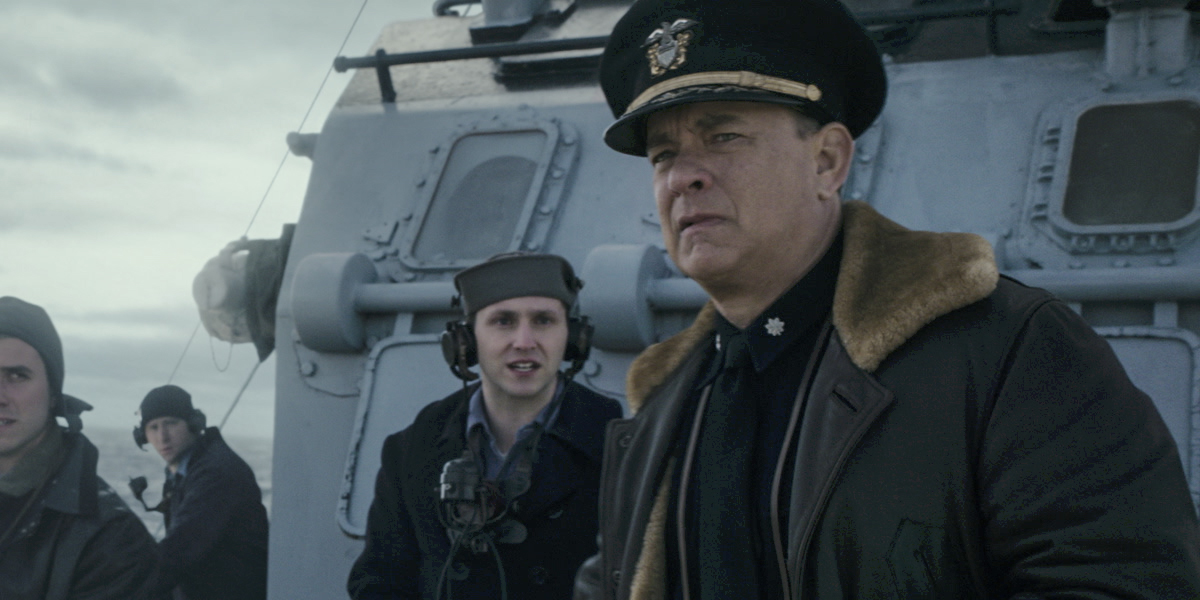Authenticity has a significant role to play in dramatic war films – particularly period pieces either inspired by or based on real events. It can be a tool used to enhance the immersiveness of the experience, the realness transporting you to a whole new time and place, and that in turn can make every major event that much more thrilling as you experience said events right alongside the characters.
There does exist, however, the danger of overcompensation. The pursuit of extreme detail and adherence to reality, even when telling what are ultimately fictional stories, can stop filmmakers from seeing the forest for the trees, and what comes out of the editing room can be likened more to an attempt at reenactment than a movie. This is the overwhelming problem with Aaron Schneider’s Greyhound.
Watching it, it very much feels like you’re being dropped on board the USS Keeling (which had the call sign “Greyhound”) for a week during World War II, but sacrificed in the process are any attempts to create memorable characters and any notion of complex narrative. Cut into segments that highlight notable events during a specific set of hours each day during a mission, it amounts to being little more than a series of at-sea skirmishes cut together – and while they are individually pretty exciting, it doesn’t add up to much dramatically.
Marking the first time that Tom Hanks has written a script he himself did not direct, Greyhound is an adaptation of the C. S. Forester novel The Good Shepherd, and centers on the multi-hyphenate as the captain of the USS Keeling, Commander Ernest Krause – who has been tasked with leading an Allied convoy transporting supplies across the North Atlantic during the early days of American intervention in World War II. What makes the journey so treacherous is that a wolfpack of German U-boats has been deployed to try and stop the ships, testing the technological capacities of the fleet.
If you love Tom Hanks shouting numbers at people, Greyhound is the movie you’ve been waiting for.
There is exactly one scene in the film that isn’t set on the boat, which is a short flashback at the beginning featuring Tom Hanks opposite Elisabeth Shue in a restaurant (essentially making her a “wife on the phone” trope who doesn’t even get a phone), and everything else is purely about maritime conflict. Zero time taken for even basic situational exposition, with that job left to white on-screen text identifying the different boats in the order, and there are few lines of dialogue that aren’t either panicked, repeated reports of enemy positioning or shouted orders. I won’t go as far as to hazard a guess as to what percentage of the footage in the movie solely features characters shouting numbers (be it coordinates or degrees to which the rudder needs to be shifted), but I will say that the real number is probably shocking.
With all of the focus of the movie being on the at-sea skirmishes, segments of the film fade to black and cut to a title card announcing the next day of the week before there is any real opportunity to see the characters reflect on their experiences and become anything more than one dimensional Navy officers, and there isn’t a great deal of room created in the preambles either. Truthfully, the most interesting individual in Greyhound is the cook played by Rob Morgan, who prepares a series of impressive meals for the captain that Krause winds up not eating because he is constantly called away to duty – and he doesn’t even stay around all that long, as a new cook takes his place later in the movie for a bit that seems to only exist to showcase an odd moment of racial microagression from the commander.
Greyhound has a strong cast that is not well utilized.
Expanding on the note above, Elisabeth Shue is a tremendously talented actress who should be doing film work much more substantial than what she’s given here – but she also isn’t entirely alone in that respect in this cast, as none of the actors really have anything to work with. There are certainly recognizable faces aboard the USS Keeling, including Stephen Graham and Manuel Garcia-Rulfo, but if the film were to have all of the actors swap roles from segment to segment it would take you significant time to notice (obviously the matching uniforms aren’t helping here). Even Tom Hanks doesn’t give himself much to work with, putting in a primarily stoic performance ironically reminiscent of his performance in the lead of Captain Phillips – but what’s entirely lacking here is anything like that character’s emotional breakdown in the film’s final minutes.
German U-Boats are the only things that go deep in Greyhound, but the action is at least impressive.
While you may not be able to differentiate between anybody on the ship, you can at least empathize with their collective situation, as the battle sequences in the film are exciting and mostly well put together. The sameness of the larger oceanic environment in combination with generally low-lit atmospheric conditions present a particular challenge in the construction of the scenes, but it’s cogently edited so that the audience has a spatial awareness of where the enemy is in relation to the USS Keeling, even while rarely cutting to the perspective of the Nazi subs.
The sense of realism is certainly achieved, as you’re left to pick up on the language and technical side of things via observation instead of explanation, and by the end of Greyhound it’s fun that you’re left with an ultra-rudimentary understanding of radar detection and communication on World War II-era battleships – making it a somewhat educational experience. It isn’t stale, though, as it keeps the explosions and tension coming, and moves briskly.
It’s so brisk, in fact, that this is actually a rare modern Hollywood film that clocks in at about 80 minutes when its end credits start to roll – though that’s not really all that surprising when you consider how much time plot and character development typically take up in movies. As such, Greyhound isn’t demanding much when it comes to attention commitment, but if you’re not yet an Apple TV+ subscriber, it also can’t be said that this is the title that should convince you to sign up. There are exciting moments, but they're rendered hollow with nothing in the movie to provide substance.

Eric Eisenberg is the Assistant Managing Editor at CinemaBlend. After graduating Boston University and earning a bachelor’s degree in journalism, he took a part-time job as a staff writer for CinemaBlend, and after six months was offered the opportunity to move to Los Angeles and take on a newly created West Coast Editor position. Over a decade later, he's continuing to advance his interests and expertise. In addition to conducting filmmaker interviews and contributing to the news and feature content of the site, Eric also oversees the Movie Reviews section, writes the the weekend box office report (published Sundays), and is the site's resident Stephen King expert. He has two King-related columns.











